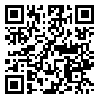1. Kamalpour S, Azizzadeh-Forouzi M, Tirgary B. A study of the relationship between resilience and academic burnout in nursing students. Strides in Development of Medical Education. 2017;13(5):476–87. [Persian] [
Article]
2. Jiménez-Ortiz J, Islas-Valle R, Jiménez-Ortiz J, Pérez-Lizárraga E, Hernández-García M, González-Salazar F. Emotional exhaustion, burnout, and perceived stress in dental students. J Int Med Res. 2019;47(9):4251–9. [
DOI]
3. Aghajari Z, Loghmani L, Ilkhani M, Talebi A, Ashktorab T, Ahmadi M, et al. The relationship between quality of learning experiences and academic burnout among nursing students of Shahid Beheshti University of medical sciences in 2015. Electron J Gen Med. 2018;15(6)1–10. [
DOI]
4. Zhang Y, Gan Y, Cham H. Perfectionism, academic burnout and engagement among Chinese college students: a structural equation modeling analysis. Pers Individ Dif. 2007;43(6):1529–40. [
DOI]
5. Naami A. Rabeteye beyne keyfiat tajarob yadgiri ba farsoodegi tahsili daneshjooyan karshenasi arshad daneshgah Shahid Chamran Ahvaz [Relationship between the quality of learning experiences and academic burnout of graduate students of Shahid Chamran University of Ahvaz]. Psychological Studies. 2009;5(3):117–34. [Persian] [
DOI]
6. Shafinaderi M, Shafeie Naderi T, Ghazanfari A, Ahmadi R. Effectiveness of training mindfulness-based stress decrease on the academic self efficacy and academic burnout in the female students with low academic performance in the secondary high school. Medical Journal of Mashhad University of Medical Sciences. 2021;63(6):2175–85. [Persian] [
Article]
7. Rudman A, Gustavsson JP. Burnout during nursing education predicts lower occupational preparedness and future clinical performance: a longitudinal study. Int J Nurs Stud. 2012;49(8):988–1001. [
DOI]
8. West CP, Dyrbye LN, Erwin PJ, Shanafelt TD. Interventions to prevent and reduce physician burnout: a systematic review and meta-analysis. Lancet. 2016;388(10057):2272–81. [
DOI]
9. Dyrbye LN, Thomas MR, Massie FS, Power DV, Eacker A, Harper W, et al. Burnout and suicidal ideation among U.S. medical students. Ann Intern Med. 2008;149(5):334. [
DOI]
10. Neumann Y, Neumann EF. Quality of learning experience and students′ college outcomes. International Journal of Educational Management. 1993;7(1):09513549310023258. [
DOI]
11. Bresó E, Salanova M, Schaufeli WB. In search of the "Third dimension" of burnout: efficacy or inefficacy? J Appl Psychol. 2007;56(3):460–78. [
DOI]
12. Martínez-Rubio D, Sanabria-Mazo JP, Feliu-Soler A, Colomer-Carbonell A, Martínez-Brotóns C, Solé S, et al. Testing the intermediary role of perceived stress in the relationship between mindfulness and burnout subtypes in a large sample of Spanish university students. Int J Environ Res Public Health. 2020;17(19):7013. [
DOI]
13. Mazerolle SM, Monsma E, Dixon C, Mensch J. An assessment of burnout in graduate assistant certified athletic trainers. J Athl Train. 2012;47(3):320–8. [
DOI]
14. Radmehr F, Heydariani L. Examine relationship of academic stress and social anxiety in students and its role in predicting the imposter syndrome. Rooyesh–e–Ravanshenasi. 2019;7(11):57–70. [Persian] [
Article]
15. Jordan RK, Shah SS, Desai H, Tripi J, Mitchell A, Worth RG. Variation of stress levels, burnout, and resilience throughout the academic year in first-year medical students. Plos One. 2020;15(10):e0240667. [
DOI]
16. Zajacova A, Lynch SM, Espenshade TJ. Self-efficacy, stress, and academic success in college. Res High Educ. 2005;46(6):677–706. [
Article]
17. Mahmoudi F, Mahmoudi A, Shahraki HR, Shamsaei M, Kakaei H. Relationship between academic burnout and economic and social factors with life expectancy in students of shiraz university of medical sciences. Int Trans J Eng Manag Sci Tech. 2019;10(2):193–201. [Persian] [
Article]
18. Asadi Arjanaki Z, Alimoradi M, Naseri M. The effectiveness of lobomirsky happiness training on happiness, life expectancy and general health of female students. Health Research Journal. 2018;3(3):139–46. [Persian] [
DOI]
19. Day L, Hanson K, Maltby J, Proctor C, Wood A. Hope uniquely predicts objective academic achievement above intelligence, personality, and previous academic achievement. J Res Pers. 2010;44(4):550–3. [
DOI]
20. Ahmadi Shurke Tucanlou. A, Asghari Ebrahimabad M J. The Role of Hope in Predicting Psychological Well-Being of Soldiers with Self-Control Mediation. Military Caring Sciences Journal. 2019;5(3):201-10. [Persian] [
Article]
21. Rajabipoor Meybodi A, Doosthosseini F. The effect of spiritual health on academic burnout with the mediator role of life expectancy. Bioethics Journal. 2018;8(28):39–47. [Persian]
22. Green SB. How many subjects does it take to do a regression analysis. Multivariate Behav Res. 1991;26(3):499–510. [
DOI]
23. Snyder CR, Harris C, Anderson JR, Holleran SA, Irving LM, Sigmon ST, et al. The will and the ways: Development and validation of an individual-differences measure of hope. J Pers Soc Psychol. 1991;60(4):570–85. [
DOI]
24. Kermani Z, Khodapanahi M, Heidari M. Vizhegi haye ravan sanjiye meghyas omid snyder [Psychometric properties of the Snyder Hope Scale]. Journal of Applied Psychology. 2011;5(3):7–23. [Persian]
25. Breso E, Salanova M, Schoufeli B. In search of the third dimension of burnout. Appl Psychol. 2007;56(3):460–72. [
DOI]
26. Bruce SP. Recognizing stress and avoiding burnout. Curr Pharm Teach Learn. 2009;1(1):57–64. [
DOI]
27. Cohen S, Kamarck T, Mermelstein R. A global measure of perceived stress. J Health Soc Behav. 1983;24(4):385. [
DOI]
28. Behroozi N, Shehni Yeylagh M, Pourseyed SM. Rabeteye kamal geraei estress edrak shode va hemayat ejtemaei ba farsoodegi tahsili [Relationship between perfectionism, perceived stress and social support with academic burnout]. Strategy for Culture. 2013,5(20):83–102. [Persian]




